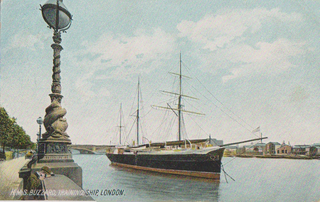
The eighth HMS Newcastle was a batch 1 Type 42 destroyer of the Royal Navy, launched in 1975. Newcastle was decommissioned on 1 February 2005.

The first HMS Shah was a 19th-century unarmoured iron hulled, wooden sheathed frigate of Britain's Royal Navy designed by Sir Edward Reed. She was originally to be named HMS Blonde but was renamed following the visit of the Shah of Persia in 1873.

HMS Implacable was a 74-gun third-rate ship of the line of the Royal Navy. She was originally the French Navy's Téméraire-class ship of the line Duguay-Trouin, launched in 1800.

HMS Buzzard was a Nymphe-class composite screw sloop and the fourth ship of the Royal Navy to bear the name.

HMS Sepoy was a 4-gun Albacore-class gunboat of the Royal Navy launched in 1856 and broken up in 1868.

Admiral Sir Anthony Hiley Hoskins, was a Royal Navy officer. As a junior officer, he took part in the Cape Frontier War of 1851 and then saw action at the Battle of Canton in December 1857 and the Battle of Taku Forts in May 1858 during Second Opium War. Once promoted to flag officer rank, he acted as Second-in-Command of the Fleet at the bombardment of Alexandria in July 1882 during the Anglo-Egyptian War. He went on to be First Naval Lord in September 1891 but in that role took a relaxed view of the size of the Fleet and did not see the need for a large shipbuilding effort on the scale envisaged by some of his colleagues, such as Admiral Sir Frederick Richards and Admiral Sir John Fisher who were concerned about French and German naval expansion.

HMS Vixen was an armoured composite gunboat, the only ship of her class, and the third ship of the Royal Navy to bear the name. She was the first Royal Navy vessel to have twin propellers.

Minerve was a 40-gun Minerve-class frigate of the French Navy. The British captured her twice and the French recaptured her once. She therefore served under four names before being broken up in 1814:

HMS Windsor Castle was a triple-decker, 102-gun first-rate Royal Navy ship of the line. She was renamed HMS Cambridge in 1869, when she replaced a ship of the same name as gunnery ship off Plymouth.

Sir Richard Vesey Hamilton was a Royal Navy officer. As a junior officer he twice volunteered to take part in missions to search for Sir John Franklin's ill-fated expedition to find the Northwest Passage. He also took part in the Battle of Fatshan Creek in June 1857 during the Second Opium War.

The Humber-class monitors were three large gunboats under construction for the Brazilian Navy in Britain in 1913. Designed for service on the Amazon River, the ships were of shallow draft and heavy armament and were ideally suited to inshore, riverine and coastal work but unsuitable for service at sea, where their weight and light draft reduced their speed from a projected twelve knots to under four. The class comprised Humber, Mersey and Severn. All three were taken over by the Royal Navy shortly before the outbreak of the First World War and were commissioned as small monitors. All three saw extensive service during the war and were sold in 1919.

HMS Sparrow was a Redbreast-class gunboat launched in 1889, the sixth Royal Navy ship to bear the name. She became the New Zealand training ship NZS Amokura in 1906 and was sold in 1922.

HMS Icarus was a Mariner-class composite screw gunvessel of 8 guns, and the third Royal Navy vessel to carry the name. She was launched in 1885 at Devonport and sold in 1904.

HMS Tickler was a Royal Navy Gadfly-class flat-iron gunboat launched in 1879. She was transferred to Simon's Town in South Africa in 1885 and converted to a steam lighter in 1902. In 1919 she became HMS Afrikander and was transferred to the South African Naval Service in 1923, becoming HMSAS Afrikander. She was returned to the Royal Navy in December 1932 and re-named HMS Afrikander II in 1933. She was finally broken up at Simon's Town in 1937.

HMS Swinger was an Ariel-class composite gunboat of the Royal Navy, built at Pembroke Dockyard and launched on 7 February 1872. She served at first on the China Station and from 1883 on the Australia Station. She was hulked in 1895 sold for breaking in 1924.
HMS Urgent was an iron screw troopship of the Royal Navy. She served her later years as a storeship and depot ship based in Jamaica.

HMS Tarantula was an Insect-class gunboat of the Royal Navy. Launched in 1915, the gunboat saw service in both the First and Second World Wars. Tarantula served with the Tigris flotilla in 1916, retaking a former British gunboat that had previously been captured by the Ottoman Empire. After the First World War, Tarantula was towed to China, joining the China Station, eventually ending up at Trincomalee, Ceylon during the Second World War. After the end of the war, the vessel was sunk as a gunnery target in the Bay of Bengal in 1946.

Vice-Admiral Sir Charles George Frederick Knowles, 4th Baronet was an officer of the Royal Navy, who saw service during the Second Burmese War and in command on the Niger expedition and quelling uprising at Santa Cruz, eventually rising to the rank of vice-admiral.

















